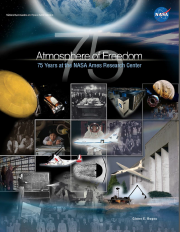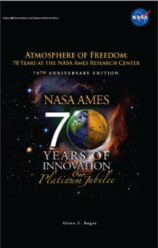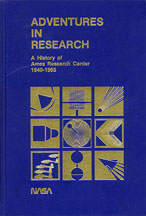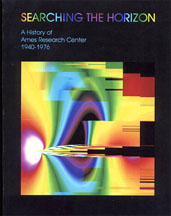Ames Research Center Staff. Some Innovations and Accomplishments
of Ames Research Center Since Its Inception. Ames Research Center.
Moffett Field, CA: NASA TM-88348, 1987.
Anderson, Seth B. "A Historical Overview of Stall/Spin
Characteristics of General Aviation." AIAA, Conference
on Air Transportation: Technical Perspectives and Forecasts,
Los Angeles, CA., August 21-24, 1978. Abstract: This contains
a review of 70 years of flight, and it draws the conclusion that
"the incorporation of the proper combination of aerodynamic
parameters to provide good stall/spin avoidance has persistently
remained an elusive goal for designers of aviation aircraft."
Anderson, Seth B. "Historical Overview of V/STOL
Aircraft Technology." AGARD The Impact of Military Applications
on Rotorcraft and V/STOL Aircraft Design. 1 June 1981. Abstract:
During the past 25 years over 60 V/STOL types were studied and
flown with varying degrees of success. The requirements for satisfactory
characteristics in several key technology areas are discussed
and a review is made of various V/STOL aircraft for the purpose
of assessing the success or failure of each design in meeting
design requirements. This survey shows that in spite of many problems
revealed, special operating techniques were developed to help
circumvent deficiencies.
Anderson, Seth B. "Historical Review of Piloted Simulation
at NASA Ames." In Flight Simulation: Where are the Challenges?.
NASA Ames Research Center, Moffett Field, CA: Conference Paper,
1 April 1996. This paper traces the conception and development
of in-flight and ground based simulators at NASA Ames Research
Center, starting in 1947 and continuing to the early 1990s.
Anderson, Seth B. "Lessons Learned from an Historical
Look at Flight Testing." AGARD Flight Testing. 1
October 1992. Abstract: A brief historical review of accidents
was made to examine lessons learned in flight testing with major
emphasis on human factors limitations.
Anderson, Seth B. Memoirs of an Aeronautical Engineer : Flight Testing at Ames Research Center, 1940-1970.
(Monograph 26 NASA-SP-2002-4526). (18.4 MB PDF file)
Anderton, David A. Sixty Years of Aeronautical Research,
1971-1977. Washington, D.C.: U.S. Government Printing Office,
1978.
Baals, Donald D. and William R. Corliss. Wind Tunnels
of NASA. Washington, D.C.: NASA SP-440, 1981.
Becker, John V. The High-Speed Frontier: Case Histories
of Four NACA Programs, 1920-1950. Washington, D.C.: NASA
SP-445, 1980.
Behan, R.A. and H.W. Wendhausen Some NASA Contributions
to Human Factors Engineering: A Survey. 1973.
Billingham, John, William Gilbreath, and Brian O'Leary (Eds.). Space Resources and Space Settlements. Washington, D.C.: NASA SP-428,
1979. This report provides results of an Ames Summer Study on Space Settlements and Industrialization Using Nonterrestial Materials. The study was directed by Gerard O'Neil at Ames in 1977. (See also Space Settlements: A Design Study).
Borchers, Paul F., James A. Franklin, and Jay
W. Fletcher. Flight
Research at Ames: Fifty-Seven Years of Development and Validation
of Aeronautical Technology (NASA SP-1998-3300).
Bugos, Glenn E. "An Aerospace Impetus to Silicon Valley."
Journal of the West. 36 (July 1997): 97-104.
Bugos, Glenn E. "Lew Rodert, Epistemological
Liaison and Thermal De-Icing at Ames." In Mack, Pamela. Editor.
From Engineering Science to Big Science: The NACA
and NASA Collier Trophy Research Project Winners (Washington,
D.C.: NASA SP-4219, 1998) 29-57.
Caroff, L. "Airborne Infrared Astronomy." Mercury.
4 (July/August 1975):2-7. Abstract: After a brief review of the
general procedures involved in airborne infrared astronomy and
of the historical background leading up to this important new
technique, sources of infrared radiation, effects of the earths
atmosphere on this incoming radiation, methods of detection of
infrared sources, and the development of airborne observatories
are described. The discussion is on a lay level; the correlation
of heat with infrared emission, the primary role played by CO2
and H2O in the opacity of the atmosphere in the IR above 18 microns,
the use of a crystal to electronically detect radiation in the
desired spectral region, and the Lear Jet telescope as mounted
in a modified C-141 cargo jet are considered.
Ceruzzi, Paul. Beyond the Limits: Flight Enters the Computer
Age. Cambridge, Massachusetts and London, England: The MIT
Press, 1989. This source contains photos and text regarding research
at Ames in wind tunnels and computational fluid dynamics. Written
at a lay level, the clear and easily comprehended prose would
be appropriate for middle school and high school students. (See
esp. pp. 134-141 for photos and text re NASA-Ames.)
Colin, Lawrence. "The Pioneer Venus Program." Journal
of Geophysical Research. 85 (30 December 1980): 7575-7598.
Abstract: The major aspects of the Pioneer Venus orbiter and multiprobe
missions are documented. Specific topics covered include a program
history, the scientific payloads, spacecraft descriptions, launch
and interplanetary cruise features, encounter features, nominal
mission descriptions, instrument anomalies, and the orbiter extended
mission. The key scientific questions addressed by the missions
are listed.
Corliss, William R. "The Interplanetary Pioneers." Washington, D.C.: NASA SP-278, 1972. Pioneers 6, 7, 8, and 9 are documented in this three-volume set. Topics include origin and history of the interplanetery Pioneer Program, system design and development, flight operations, and scientific results.
Volume I: Summary
Volume II System Design and Development
Volume III: Operations
Corneliussen, Steven T. "The Transonic Wind Tunnel and
the NACA Technical Culture." In Mack, Pamela. Editor. From
Engineering Science to Big Science: The NACA and NASA Collier
Trophy Research Project Winners. Washington, D.C.: NASA SP-4219,
1998. Pp. 91-134.
Craig, R.A. "The Pioneer Venus Extended Mission."
Spaceflight. 27 (December 1985): 445-450. This source
contains a history of the Pioneer Venus Orbiter as well as a presentation
of the ongoing and future missions (through reentry 1992).
DeAnza College. California History Center. Series of videotapes
including symposiums and interviews of Ames Research Center researchers,
engineers, and test pilots. E.g. Aerospace History: A Symposium
on the Early Days of Ames Research Center, According to Test Pilots,
1984. Also Ames Research Center: Its Past, Present and Future:
A Discussion by Sy Syvertson and William Ballhaus, 1985.
The California History Center is also in possession of several
unpublished research papers on Ames Research Center.
Dethloff, Henry C. The Space Shuttle's First Flight: STS-1.
In Mack, Pamela. Editor. From Engineering Science to Big Science:
The NACA and NASA Collier Trophy Research Project Winners.
Washington, D.C.: NASA SP-4219, 1998. Pp. 277-297. See p. 279
esp. Dethloff locates the origins of the space shuttle idea in
a NACA Ames secret report, "Preliminary Investigation of
a New Research Airplane for Exploring the Problems of Efficient
Hypersonic Flight."
DeVincenzi, Donald L., Margaret S. Race, and Harold P. Klein.
"Planetary Protection, Sample Return Missions and Mars Exploration:
History, Status and Future Needs." Journal of Geophysical
Research 103 (25 November 1998) 28: 577-585. The authors
are affiliated with NASA Ames Research Center and with the Search
for Extraterrestrial Intelligence (SETI) Institute. Abstract:
This article includes a discussion of the historical precedent
for the use of Planetary Protection (PP) measures on both unmanned
and manned missions, and it presents a comprehensive review of
the major issues and problems surrounding PP for a Mars Sample
Return (MSR) mission. Also discussed are the history and foundations
for PP policies and requirements.
Dick, Steven J. and Keith Cowing, eds. Risk and Exploration: Earth, Sea and the Stars, Proceedings from the NASA Administrator's Symposium, September 26-29, 2004, Naval Postgraduate School, Monterey, California.Washington, D.C.: NASA SP-2005-4701, 2004. Especially the chapter by Nathalie Cabrol
Dolci, Wendy Whiting. "Milestones in Airborne Astronomy:
From the 1920's to the Present." AIAA, 1997 World Aviation
Congress, October 13-16, 1997, Anaheim, CA.
Duffner, Robert W. Airborne Laser: Bullets of Light.
New York and London: Plenum Trade, 1997. See pp. 104-107 for discussion
of Hans Mark's successful attempt to have Ames Research Center
chosen over Arnold as a test facility for airborne laser aerodynamic
work.
Edwards, Kristen E."The US-Soviet/Russian
Cosmos Biosatellite Program," Quest: The History of Spaceflight
Quarterly 7/3 (Fall 1999) 20-35.
Erickson, Edwin F. and Allan W. Meyer. NASA's Kuiper Airborne Observatory, 1971-1995: An Operations Retrospective with a View to SOFIA
(NASA SP-2013-216025, December 2013). (58.4 MB PDF file)
Few, David D. A Perspective on 15 Years of Proof-of-Concept
Aircraft Development and Flight Research at Ames-Moffett by Rotorcraft
and Powered-Lift Flight Projects Division, 1970-1985. NASA
Ames Research Center, Moffett Field, CA: NASA RP-1187, 1987.
Fimmel, Richard O., James Van Allen, and Eric Burgess. Pioneer: First to Jupiter, Saturn, and Beyond. Washington, D.C.: NASA SP-446, 1980. This source documents the Pioneer 10 and 11 missions to Jupiter and Saturn.
Fimmel, Richard O., William Swindell, and Eric Burgess. Pioneer
Odyssey: Encounter with a Giant. Washington, D.C.: NASA SP-349, 1977. This source documents the Pioneers 10 and 11 missions.
Fimmel, Richard O., Lawrence Colin, and Eric Burgess. Pioneer
Venus. Washington, D.C.: NASA SP-461, 1983. This source documents the history of the Pioneer Venus Program.
Fimmel, Richard O., Lawrence Colin, and Eric Burgess. Pioneering
Venus: A Planet Unveiled. Washington, D.C.: NASA SP-518,
1995. This source documents the history of the Pioneer Venus Program.
Fries, Sylvia. NASA
Engineers and the Age of Apollo. Washington, D.C.: NASA
SP-4104, 1992.
Garber, Stephen J. "Searching for Good Science: The Cancellation
of NASA's SETI Program." Journal of the British Interplanetary
Society. 52 (1999): 3-12. Despite its centrality in the SETI
program, Ames Research Center is referred to infrequently in this
article. Still, Garber covers the history of the SETI project
and mentions the involvement of Ames life sciences researchers
John Billingham and Jill Tarter.
Gelzer, Christian (Ed). NASA Armstrong Flight Research Center's Contributions to the Space Shuttle Program. Edwards, CA: NASA SP-2020-4322, 2021. This publication provides a history of NASA Armstrong Flight Research Center's role in the Space Shuttle program. Contributions from Ames are noted throughout.
Graeber, R. Curtis, John K. Lauber, Linda J. Connell, and
Philippa Gander. "International Aircrew Sleep and Wakefulness
after Multiple Time Zone Flight ? A Cooperative Study." Aviation,
Space, and Environmental Medicine. 57 (1 December 1986):
B3-B9. Abstract: This paper provides an overview of the project's
history, its research design, and the standardization of procedures.
All of the authors were affiliated with NASA Ames Research Center.
Gray, George. Frontiers of Flight. New York: Alfred
A. Knopf, 1948.
Hallion, Richard P. On the Frontier: Flight Research at
Dryden, 1946-1981. Washington, D.C.: NASA SP-4303, 1984.
This source contains numerous references to Ames Research Center,
including discussion of the AD-1, a cooperative venture between
Ames and Dryden in which the two centers worked on a research
airplane designed with an oblique or "scissors" variable
sweep wing design developed by Robert T. Jones.
Hallion, Richard P. "Lippisch, Gluhareff, and Jones:
The Emergence of the Delta Platform and the Origins of the Sweptwing
in the United States." Aerospace Historian 26 (March
1979):110.
Hallion, Richard P. "The Space Shuttle's Family Tree."
Air and Space/Smithsonian. 6 (1991, Number 1): 44-46.
Heppenheimer, T.A. Countdown: A History of Space Flight.
New York: John Wiley and Sons, Inc., 1997. See chapter ten on
the unmanned space programs for a discussion of Ames in relation
to the Pioneer Venus and Voyager missions.
Hoffman, Stephen J. and David I. Kaplan (eds.). Human Exploration of Mars: The Reference Mission of the NASA Mars Exploration Study Team.
Houston, TX: NASA SP-6107, July 1997. This source details an approach to designing human missions to Mars. Several Ames scientists and engineers contributed to the study.
Hubbard, G. Scott. Exploring Mars: Chronicles from a Decade of Discovery.
Tucson, AZ: The University of Arizona Press, 2011. This book provides former Ames Center Director Scott Hubbard's account of how he led efforts to restructure NASA's Mars program to enable a series of successful missions, from Mars Odyssey to Mars Science Laboratory.
Hurd, R. Michael. The Illiac IV, the First Supercomputer.
Rockville, MD: Computer Science Press, Inc., 1982. This source
contains a discussion as to why the Illiac was placed at Ames
instead of at the University of Illinois.
Johnson, Richard D. and Charles Holbrow (Eds.). Space Settlements: A Design Study. Washington, D.C.: NASA SP-413,
1977. This report provides results of a ten-week study examining how to permanently sustain life in space in large settlements. The study was conducted by Ames and Stanford University in 1975 and followed up with a second one in 1977 (see Space Resources and Space Settlements).
Kargon, Robert, Stuart W. Leslie, and Erica Schoenberger.
"Far Beyond Big Science: Science Regions and the Organization
of Research and Development." In Galison, Peter and Hevly,
Bruce. Editors. Big Science: The Growth of Large-Scale Research.
Stanford, CA.: Stanford University Press, 1992. Pp. 334-354.
Leslie, Stuart W. The Cold War and American Science: The
Military-Industrial-Academic Complex at MIT and Stanford.
New York, Columbia University Press, 1993. See p. 114 and pp.
118-119 for a discussion of the relationship between Lockheed,
Stanford University, and NACA Ames Research Center as all three
entities pursued missile research in the late 1940s and 1950s.
Levine, Arnold and Hans Mark. The Management of Research
Institutions: A Look At Government Laboratories. Washington,
D.C., NASA SP-481, 1984.
Levine, Arnold S. Managing
NASA in the Apollo Era. Washington, D.C.: NASA SP-4102,
1982.
Loftin, Lawrence, Jr. Quest for Performance: The Evolution
of Modern Aircraft. Washington, D.C.: NASA SP-468, 1985.
Available online through the NASA website.
Lynn, Robert R. "The Rebirth of the Tiltrotor? The 1992
Alexander A. Nikolsky Lecture." American Helicopter Society
Journal 38 (January 1993):3-16. Abstract: The present development
history of tilt-rotor VTOL aircraft gives attention to the critical
technology demonstrator program on the basis of whose results
the XV-15 proof-of-concept aircraft was developed. The most important
figure in the XV-3 development was Robert Lichten, who had taken
part in the creation of the small Transcendental Model 1G tilt-rotor
experimental aircraft. Two- and three-bladed, rigid and semirigid
rotors were tested in tilt-wing VTOL operation during the course
of XV-3 flight testing; deficiencies noted during USAF/US Army-sponsored
flight tests in 1956-1957 were addressed upon the XV-3's turning
over to NASA-Ames for additional investigations in 1959. Full-scale
tunnel testing of the XV-3 was undertaken by NASA in 1962.
Maisel, Martin D., Demo J. Giulianetti, and Daniel
C. Dugan. The History of the XV-15 Tilt Rotor Research Aircraft: From Concept
to Flight (Monograph 17 NASA SP-2000-4517). (2.42 MB PDF file)
Marlaire, Ruth Dasso. James B. Pollack and NASA's Planetary Missions: A Tribute (NASA SP-2017-632). (2.1 MB PDF file)
Mark, Hans. The Space Station: A Personal Journey.
Durham: Duke University Press, 1987. See pp. 30-58 including Chapter
five, "The Start at Ames and the Space Shuttle," and
Chapter six, "Development of the Shuttle."
McCurdy, Howard. Inside NASA: High Technology and Organizational
Change in the U.S. Space Program. Baltimore, MD: Johns Hopkins
University Press, 1993.
Moin, Parviz, and John Kim. "Tackling Turbulence with Supercomputers."
Scientific American. 276 (January 1997): 62-68. This
article contains a development history and current status evaluation
for flow visualization methods concerned with the characterization
and prediction of turbulent aerodynamic flows.
Montoya, Earl J. and Richard O. Fimmel. Space Pioneers and
Where They Are Now. NASA Ames Research Center, Moffett Field,
CA: NASA EP-264 (Technical Report), 1 January 1987. This contains
a description of the Pioneer project, its history and achievements.
Mort, Kenneth W. The World's Largest Wind Tunnels: Their History, Contributions to Aeronautics, and Importance to Flight. A History of the NASA Ames 40- by 80-Foot and 80- by 120-Foot Wind Tunnels. (NASA SP-2020-5009237, December 2020). (159.9 MB PDF file)
National Aeronautics and Space Administration. The
Martian Landscape.
Washington, D.C., NASA SP-425, 1978. This book contains anecdotal accounts of the Viking Lander imaging efforts by science team members and extensive photographs of the Martian surface as captured by Viking Landers 1 and 2.
National Aeronautics and Space Administration. Viking 1: Early Results.
Washington, D.C., NASA SP-408, 1976. This work provides an overview of the Viking mission and discusses early findings.
Ormiston, Robert and Irving Statler (Eds.). Figures of Merit: Remembrances of Those Who Built an Army-NASA Collaboration and a New Age of Rotary-Wing Technology, 1965-1985. Moffett Field, CA: NASA SP-2018-3713, 2018. A collection of memoirs by 40 scientists, engineers, technicians, secretaries, test pilots, and leaders who built a unique interagency collaboration under an Army-NASA Joint Agreement at Ames.
Pitts, John. The
Human Factor: Biomedicine in the Manned Space Program to 1980.
Washington, D.C., NASA SP-4213, 1985.
Reed, R. Dale, and Darlene Lister. Wingless Flight: The
Lifting Body Story. Foreword by General Chuck Yeager. Washington,
D.C.: NASA SP-4220, 1997.
Roland, Alex. Model Research: The National Advisory Committee
for Aeronautics, 1915-1958, (2 volumes). Washington, D.C.,
Government Printing Office, 1985.
Volume 1
Volume 2
Ronca, April E., Kenneth A. Souza, and Richard C. Mains Translational Cell and Animal Research in Space 1965-2011 (Moffett Field, CA: NASA SP-2015-625, 2015). This book includes one-page descriptions of experiments, grouped by science discipline area, for NASA Ames-managed animal and related cell spaceflight research from missions conducted between 1965 and 2011. (26.2 MB PDF file)
Souza, Kenneth A., Robert Hogan, and Rodney Ballard, eds. Life into Space: Space Life Sciences Experiments. NASA Ames Research Center 1965—1990 (NASA RP-1372).
Adobe® Acrobat PDF File (10.5 MB) | archived html version
Rotundo, Louis. Foreword by Chuck Yeager. Into the Unknown:
The X-1 Story. Washington and London: Smithsonian Institution
Press, 1994. See p. 12 for discussion of wind tunnels. Also see
pp. 161-162 for mention of Ames, Lewis Rodert, and 1947 tests
performed at NACA Ames for the XS-1 in cooperation with Bell technicians.
Rosekind, M.R. "Crew Factors in Flight Operation: The Initial
NASA-Ames Field Studies on Fatigue." Aviation Space and
Environmental Medicine. 69 (September 1998): 2.
Saar, John. "Space-Age Wind Tunnels Reshape Old Notions
of Streamlining." Smithsonian. 12 (1982, Number
10): 76-85. Abstract: This follows the development of the wind
tunnel and its importance in the advancement of flight, from the
Wright brothers' experiments in preparation for their flight in
1903 to the world's largest wind tunnel for aerospace research
under construction at the Ames Research Center at Moffett Field,
California.
Smith, Robert W. with Paul Hanle, Robert Kargon, and Joseph Tatarewicz. The Space Telescope: A Study of NASA, Science, Technology
and Politics. New York and London: Cambridge University Press,
1989.
Sonnett, C.P. "Romancing the Solar System [personal history
of solar-system studies]." Journal of Geophysical Research.
99 (October 1994):17-19, 187. Abstract: This article covers the
present development history for the early phases of satelliteborne
instruments and the investigation of the ionosphere. The article
is drawn from the experiences of a researcher who served in the
capacity of Project Scientist for Pioneers 1, 2, 5 and Explorer
6, as well as NASA Chief for Lunar and Planetary Science. Accounts
are given of the Able spacecraft, the instrument suites of the
Pioneer spacecraft, NASA's program management development, and
the role of NASA-Ames in magnetospheric and solar wind studies.
Souza, Kenneth A., Guy Etheridge, and Paul X. Callahan, eds. Life into Space: Space Life Sciences Experiments. Ames Research Center, Kennedy Space Center, 1991—1998. Washington DC: National Aeronautics and Space Administration, 2000 (NASA SP-2000-534).
Adobe® Acrobat PDF File (23.2 MB) | archived html version
Souza, Kenneth A., ed. Life into Space: Space Life Sciences Experiments. Ames Research Center, 1998—2003. National Aeronautics and Space Administration, 2005.
archived html version
Spahr, J. Richard and Charles F. Hall. The Pioneer Projects: Economical Exploration of the Solar System. NASA Ames Research
Center, Moffett Field, CA.: NASA TM X-62481, September 1975.
Stager, Leslie and Lynn Morgan. "Organizational Coma:
The Effect of the U.S. Government's Budget Furloughs on NASA Ames
Research Center." OD Practitioner 29 (1997, Number
4): 39-48.
Stillwell, Wendell. X-15
Research Results with Selected Bibliography. Washington,
D.C.: NASA SP-60, 1965.
Vincenti, Walter G. "Engineering Theory in the Making:
Aerodynamic Calculation Breaks the Sound Barrier. Technology
and Culture 38 (October 1997).
Vincenti, Walter G. What Engineers Know and How They Know
It: Analytical Studies in the History of Aeronautical History.
Baltimore, Johns Hopkins University Press.,1990.
Von Bencke, Matthew J. The Politics of Space: A History
of US-Soviet/Russian Competition and Cooperation in Space.
Westview Press, 1997. This contains a chronology of all Cosmos
launches. Though there is no specific mention of Ames Research
Center, this source covers the Cosmos program, including Cosmos
Bion.
Ward, John. "An Updated History of NACA/NASA Rotary-Wing
Aircraft Research, 1915-1984." Vertiflite 30 (May/June
1984): 108-117. Abstract: This article draws upon highlights from
A History of NACA/NASA Rotating-Wing Aircraft Research, 1915-1970,
by F. Gustafson to build an historical base upon which to build
an extension from 1970-1984. Fundamental changes in how NASA conducted
rotary-wing research in the early 1970s included an increasing
level of contract research and closer ties with research conducted
by the U.S. Army. The work done at the Army Research Laboratories
at Ames, Langley, and Lewis Research Centers during 1970-1976
is briefly reviewed. In 1976 the Ames Research Center was assigned
the Lead Center responsibility for helicopter research, though
Langley retained research roles in structures, noise, dynamics,
and aeroelasticity in support of rotorcraft. By 1984, NASA Rotorcraft
Program Funding reached $35 million per year.
Wolverton, Mark, "Pathfinding the Rings:
The Pioneer Saturn Trajectory Decision." Quest: The History
of Spaceflight Quarterly 7/4 (Spring 2000) 5-11.
Yu, Kelvin. "Project Controls: Cost/Schedule/Progress Management
on the NASA Wind Tunnel Restoration Project." Cost Engineering.
38 (4 April 1996, Number 4): 25-32.
(Compiled by Karen Dunn-Haley, Glenn Bugos, Leilani Marshall, and April Gage.)







